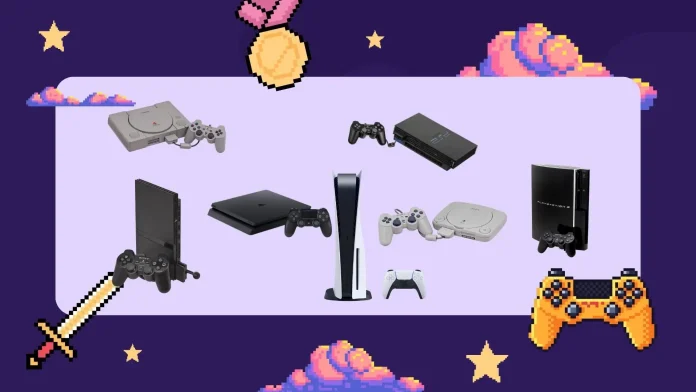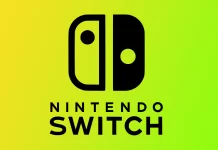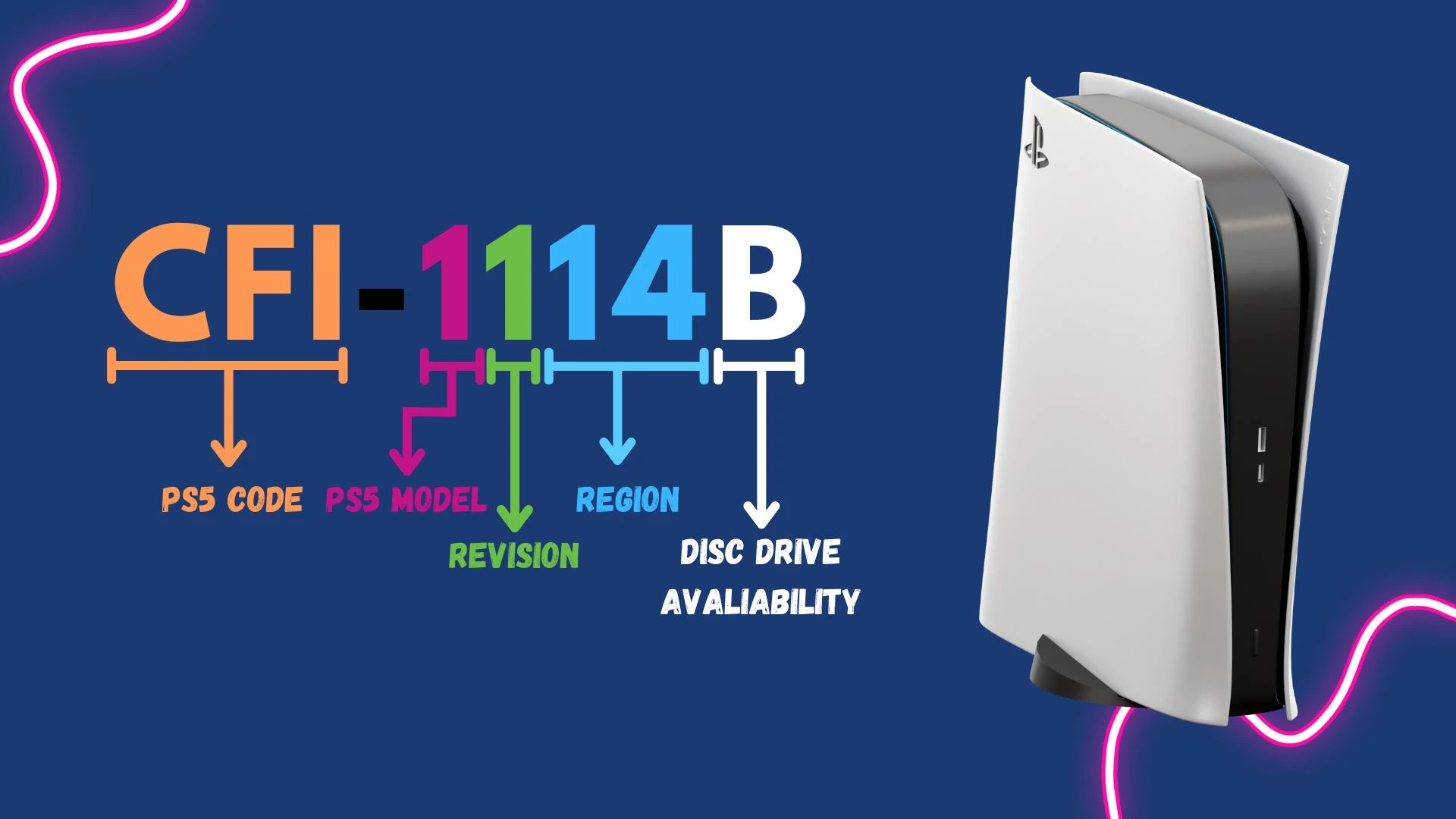The story of PlayStation began in the early 90s when it was born from a failed collaboration between Sony and Nintendo. The partnership fell through. The PlayStation was initially intended to be a CD-ROM add-on for the Super Nintendo. Sony, undeterred, decided to forge its path in the gaming world. In 1994, the original PlayStation was born.
Over the years, Sony has rolled out five PlayStation gens. Sony also released enhanced and compact versions of some consoles, like the PS One, PS2 Slim, PS3 Slim and Super Slim, PS4 Slim, and PS4 Pro, and more recently, the PS5 Slim. They’ve added VR and VR 2 to this lineup as well.
So, let’s kick off from 1994 and see how PlayStation has evolved year after year.
PlayStation (1994)
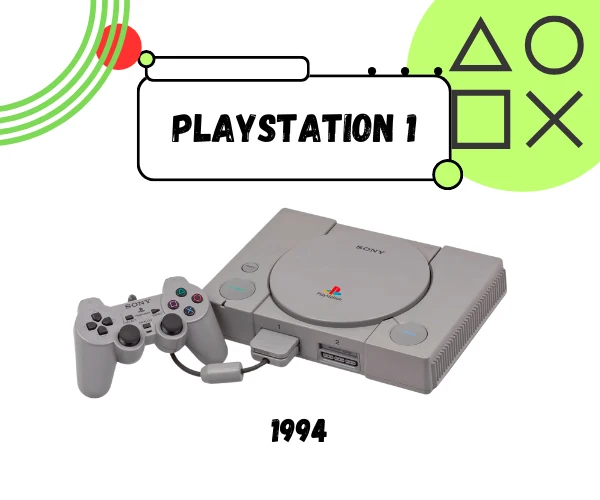
- Release date: December 3, 1994 (Japan), then 1995 in other countries
- Launch Prices: $299
- Discontinued: March 23, 2006
- Units Sold: Over 102.49 million
- Colors: Grey
- Media: CD-ROM
- CPU: R3000 processor at 33.8688 MHz
- Resolution: 256×224, 640×480 (SD)
- Memory: 2 MB RAM, 1 MB VRAM
- Storage: Memory card
- Sound: 16-bit, 24-channel ADPCM
- Connectivity: PlayStation Link Cable
Back in ’94, Sony came out with the PlayStation, their first-ever game console. It was a big deal in the gaming world. Initially, it was meant to be part of the Super Nintendo, but PlayStation quickly evolved into its standalone project after Sony’s partnership with Nintendo fell through. The guy who led this project, Ken Kutaragi, made it special. They even call him the “Father of the PlayStation.”
The PlayStation hit the stores in Japan first, then made its way to North America and Europe in 1995. It was a hit right off the bat, selling a whopping 100 million units super fast.
PlayStation used CD-ROMs instead of cartridges. They had a larger capacity and faster reading speed. This allowed developers to create more expansive and complex games. A key to PlayStation’s success was its open approach to third-party game development, leading to a diverse library of games. Some of the most iconic PlayStation games include “Gran Turismo,” “Tomb Raider,” and “Final Fantasy VII.”
Regarding the tech side, PlayStation had it all over its rivals, Sega Saturn and Nintendo 64. Those CDs could hold more games than cartridges with better graphics and sound.
PlayStation 2 (2000)
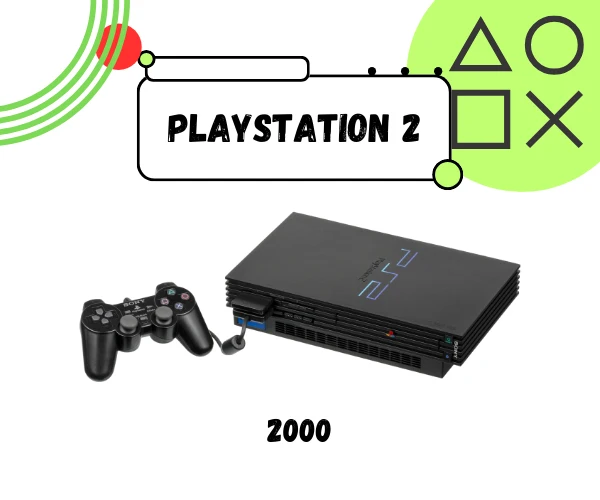
- Release Date: March 4, 2000
- Launch Prices: $299
- Discontinued: January 4, 2013
- Units Sold: Over 155 million
- Media: DVD-ROM, CD-ROM
- CPU: 299 MHz ‘Emotion Engine’
- Resolution: Up to 1080i
- Memory: 32 MB of RDRAM
- Storage: Memory card (8 MB)
- Sound: “SPU1+SPU2” with 48 Channels
- Controller Input: DualShock 2 controller
- Connectivity: 2 USB 1.1 ports, 100Mbit Ethernet
The PlayStation 2 (PS2) development began in secrecy around the time the original PlayStation was unveiled in December 1994. Sony officially announced the PS2 in 1999, positioning it as a rival to Sega’s upcoming Dreamcast. However, the Dreamcast’s early success fizzled out, and Sony’s real competition came from Nintendo.
The PS2, released in 2000, became a gaming legend, selling over 155 million units until its discontinuation in 2013. Its 12-year lifespan, even overlapping with the next generation of consoles, is one of the longest for any gaming system. By the time production ceased, over 3800 unique games had been released for the PS2, with more than 1.5 billion games sold.
A key feature of the PS2 was its built-in DVD player, leveraging the larger storage capacity of DVD-ROMs. The PS2 also doubled as a device for watching movies on DVDs.
The console boasted exclusive titles like “Grand Theft Auto,” “Final Fantasy,” and “Metal Gear Solid.” Franchises like “Kingdom Hearts,” “God of War,” and “Devil May Cry” started on the PS2, with “Grand Theft Auto: San Andreas” becoming its best-selling game. The PS2 also supported online multiplayer gaming with a broadband connection and the PlayStation 2 Network Adapter.
PS One (2000)
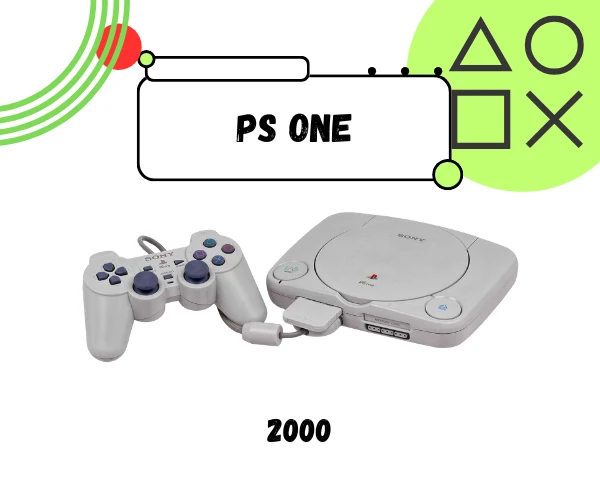
- Release date: July 7, 2000
- Launch Prices: $299
- Discontinued: March 26, 2006
- Units Sold: 28.15 million
- Colors: White
- Media: CD-ROM
- CPU: RISC MIPS R3000A (32-bit) – 33 MHz
- Resolution: 256×224, 640×480 (SD)
- Memory: 2 MB EDO DRAM
- Storage: 1 MB
- Sound: 16-bit, 24 Channel ADPCM, Stereo
- Connectivity: 2 x USB, FireWire
In 2000, Sony brought out the PS One. It was a cool, smaller version of the original PlayStation. Sony did this to offer a cheaper option alongside the new PlayStation 2. The PS One looked different with its white color and had some tweaks like a combo power and reset button. It didn’t have some of the ports the old one had, making it simpler.
What made the PS One special? People loved it because it played all the old PlayStation games in a fresh, new package. The last PS One consoles were sold in late 2006, shortly after being discontinued.
PlayStation 2 Slim (2004)
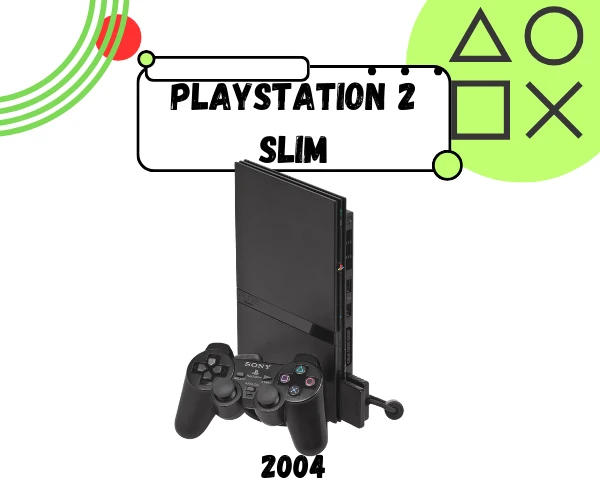
- Release date: 2004
- Launch Prices: $299
- Discontinued: January 4, 2013
- Media: DVD, CD
- CPU: MIPS R5900 (64-bit) – 294 MHz
- Resolution: 720×480 (SD), 1280×720 (HD)
- Memory: 32 MB RDRAM, 4MB eDRAM
- Storage: 40 GB
- Sound: 5.1 Surround Sound, Stereo
- Connectivity: Ethernet, 2 USB 1.1 ports
In 2004, Sony rolled out the PlayStation 2 Slim, a sleeker, smaller version of the classic PS2. It was a hit right from the start, quieter and ready for online gaming with its built-in Ethernet port.
However, Sony had to remove the internal hard drive support to make it slim. But don’t worry, it still had the same power as the original PS2, with the same CPU and GPU, ensuring all your favorite games ran smoothly.
Sony faced a little hiccup with the PS2 Slim. Some early models had overheating issues, but Sony quickly fixed this.
Sony didn’t expect the huge demand for the PS2 Slim. Soon after its release, they faced a supply shortage. The situation got trickier when the Suez Canal got blocked. In November 2004, this blockage stopped PS2 Slim deliveries to the UK for a week.
PlayStation Portable (2004)
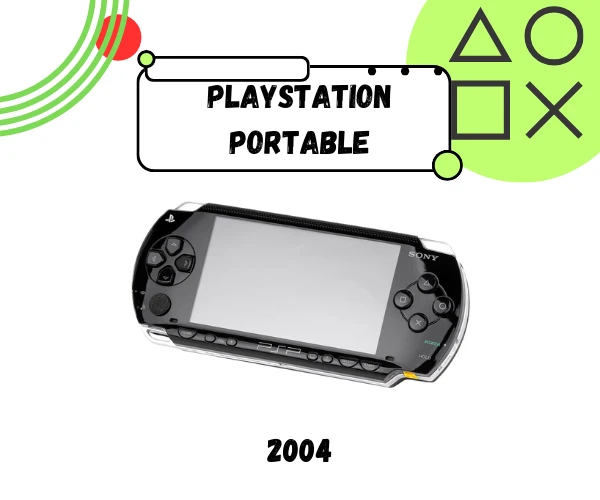
- Release date: December 12, 2004
- Launch Prices: $249.99
- Discontinued: June 2014
- Units Sold: About 80-82 million
- Colors: Black
- Media: UMD, digital downloads
- CPU: 33 MHz MIPS R4000
- Resolution: 480 × 272 pixels
- Memory: 32 MB (original version), 64 MB (PSP-2000 and later)
- Storage: Memory Stick Duo, Memory Stick PRO Duo
- Sound: Stereo speakers, Mono speaker (PSP-1000)
- Connectivity: Wi-Fi (802.11b), IrDA, USB 2.0
In 2004, Sony introduced the PlayStation Portable, or PSP. This was Sony’s first handheld game console, and it was a big deal. Unlike the PlayStation 2, the PSP lets you play games anywhere.
The PSP was influential as a handheld device. Its good processor and graphics made games look great on its 4.3-inch screen. It was more than just a game console; you could also watch movies using special discs called UMDs.
One cool feature of the PSP was Wi-Fi. This was new for handheld consoles, allowing you to connect to the Internet. The PSP had many different games, including popular ones like Grand Theft Auto: Liberty City Stories. It wasn’t just about famous games, though. The PSP had all sorts of games, from adventure to racing.
Sony’s PSP was a bold move. It showed they were ready to try new things in gaming. The PSP wasn’t just a smaller PlayStation. It was a new way to play games on the go, with many features and a great selection.
PlayStation 3 (2006)
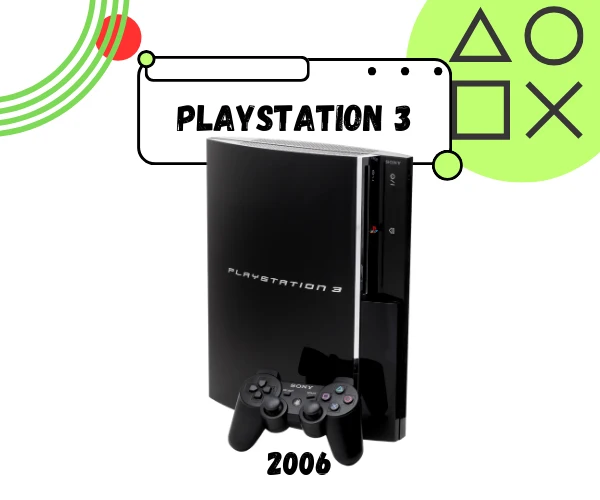
- Release date: November 11, 2006
- Launch Prices: $499
- Discontinued: October 2016
- Units Sold: 87.4 million
- Color: Black
- Media: Blu-ray, DVD, CD, digital downloads
- CPU: Cell Broadband Engine
- Resolution: Up to 1080p
- Memory: 256 MB XDR DRAM
- Storage: 20 GB, 60 GB, 80 GB, 160 GB, 250 GB, 320 GB, 500 GB (depending on model)
- Sound: Dolby Digital Plus, Dolby TrueHD, DTS-HD
- Controller Input: Sixaxis, DualShock 3
- Connectivity: Ethernet, Wi-Fi, Bluetooth 2.0, 4 USB 2.0 ports
In 2006, Sony launched the PlayStation 3 (PS3), a game-changer in the truest sense. This wasn’t just an upgrade from the PS2 but a whole new gaming world. The PS3 was the first console to use Blu-ray Discs, offering more storage for games and movies. It was also the first PlayStation to connect with handheld consoles, like the PSP, for remote gaming.
The PS3’s heart was its Cell Broadband Engine CPU, a powerhouse for gaming. It had a 6-core processor and a GPU from Nvidia, making games look stunning. The console supported HDMI for high-definition visuals, a big leap from the PS2.
Sony also introduced the PlayStation Network with the PS3. This was huge, allowing online gaming, digital game downloads, and social features. The PS3 was more than a console; it was a multimedia hub.
But the PS3’s journey wasn’t all smooth. Its high launch price initially turned off some gamers, and its complex architecture made it challenging for developers. Despite these hurdles, the PS3 gained popularity, especially after Sony released a slimmer, more affordable version in 2009.
The PS3’s game library was impressive. Titles like ‘Grand Theft Auto V’ and ‘The Last of Us’ were massive hits. The console sold millions.
PlayStation 3 Slim (2009)
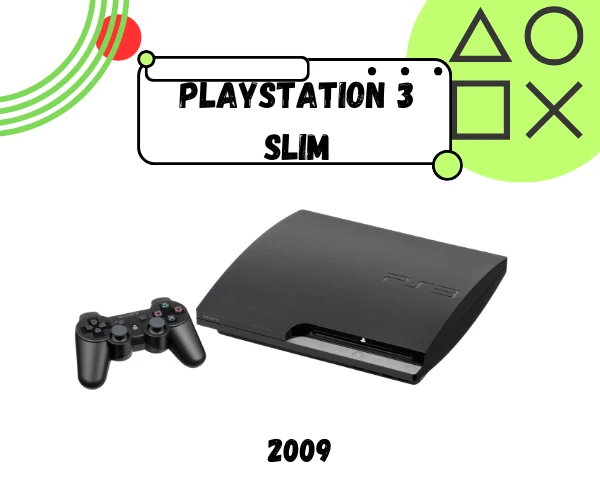
- Release date: September 1, 2009
- Launch Prices: $299 (120 GB), $349 (250 GB) (USA)
- Discontinued: October 2016
- Units Sold: 16 million
- Color: Black
- Media: Blu-ray, DVD, CD, digital downloads
- CPU: Cell Broadband Engine
- Resolution: Up to 1080p
- Generation: Seventh Generation
- Memory: 256 MB XDR DRAM
- Storage: 120 GB, 250 GB, 320 GB (depending on model)
- Sound: Dolby Digital Plus, Dolby TrueHD, DTS-HD
- Controller Input: DualShock 3
- Connectivity: Ethernet, Wi-Fi, Bluetooth 2.0, 2 USB 2.0 ports
In 2009, Sony introduced the PlayStation 3 Slim, a sleeker, more efficient version of the original PS3. This wasn’t just a cosmetic upgrade but a significant redesign addressing many of the original PS3’s issues.
The PS3 Slim was 32% smaller, 36% lighter, and consumed 34% less power than its predecessor. This made it not just more space-efficient but also more energy-efficient. Sony also revamped the design, giving it a more modern and streamlined look.
Under the hood, the PS3 Slim packed the same powerful Cell Broadband Engine CPU and Nvidia/SCEI RSX GPU as the original. However, Sony made some key changes. They moved the Cell microprocessor to a 45 nm manufacturing process, making the console cooler and quieter. The RSX also got an update, moving to a 40 nm process.
One of the biggest changes was removing the hardware ability to run PlayStation 2 games, focusing solely on PS3 titles. The Slim model also featured an upgradeable hard drive, with options ranging from 120 GB to 320 GB, providing plenty of space for games, movies, and other media.
PSP Go (2009)
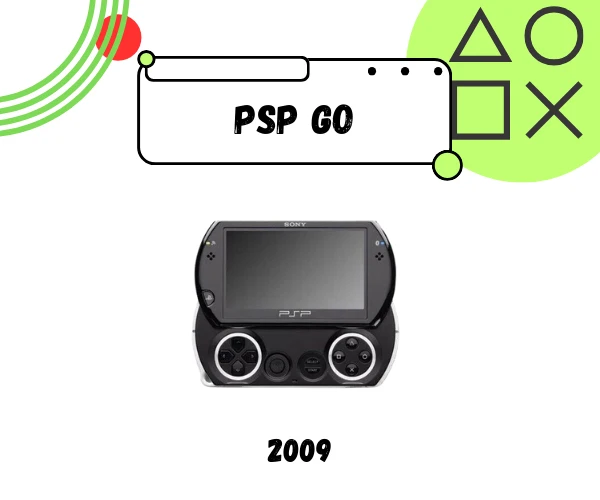
- Release date: October 2009
- Launch Prices: $250
- Discontinued: April 2011
- Units Sold: 55.9 million
- Color: Black, White
- Media: Digital downloads only
- CPU: 333 MHz MIPS R4000
- Resolution: 480 × 272 pixels
- Memory: 64 MB
- Storage: 16 GB internal
- Sound: Stereo speakers
- Controller Input: Built-in buttons
- Connectivity: Wi-Fi, Bluetooth, USB 2.0
Compared to the original PlayStation Portable released in 2004, the PSP Go was a different ball game. First off, it was way smaller and lighter. You could easily slip it into your pocket, making it super portable. The design was slick, too – this cool sliding mechanism hid the controls when not in use.
But the real game-changer was the storage and media. The PSP Go is packed with 16GB of internal flash memory. That’s a big deal because, unlike the older PSP, you didn’t need those memory sticks to store your games and movies. Everything was stored internally or downloaded, keeping things tidy.
However, let’s chat about the features. The PSP Go had a 3.8-inch screen, not too shabby for handheld gaming. And it wasn’t just about games – with Wi-Fi and Bluetooth, you could jump online or connect to other devices. Sony even thought about how to use a PS3 controller with it, which was pretty neat for playing games on a bigger screen.
But here’s the catch – the PSP Go’s transition to digital wasn’t smooth for everyone. It came with a higher price, and not everyone was ready to ditch physical games for downloads. So, despite its fancy features, the sales didn’t quite hit the mark like the original PSP.
PlayStation Vita (2011)
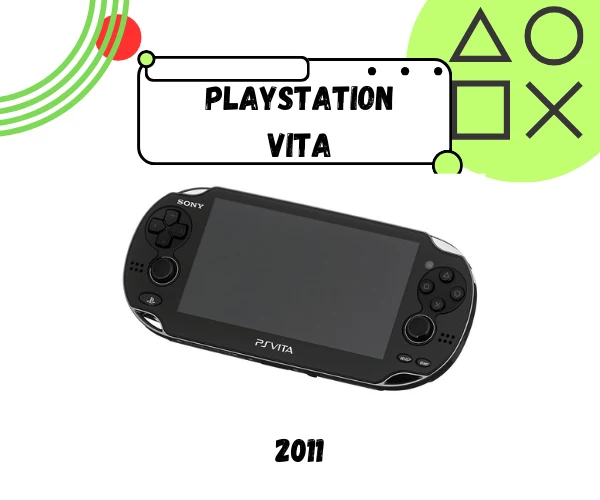
- Release date: December 2011 (Japan), February 2012 (Worldwide)
- Launch Prices: $249.99
- Discontinued: March 2019
- Units Sold: 16 million
- Color: Various
- Media: PS Vita Card, digital downloads
- CPU: Quad-core ARM Cortex-A9 MPCore
- Resolution: 960 x 544. OLED 16:9
- Memory: 512 MB RAM, 128 MB VRAM
- Storage: Proprietary PS Vita memory cards
- Sound: Stereo speakers
- Controller Input: Built-in buttons, touchscreen
- Connectivity: Wi-Fi, 3G (optional), Bluetooth, GPS (3G model only)
Sony launched the PlayStation Vita in 2011 with some cool features. It had a 5-inch OLED screen, which was ahead of its time. The Vita was robust, with a quad-core CPU and GPU, great for gaming on the go. But, sales didn’t hit Sony’s targets. They wanted to sell tens of thousands monthly in North America, but that didn’t happen. Overall, about 15-16 million units were sold worldwide.
In 2013, Sony updated the Vita. The new version was lighter and thinner. They switched the OLED for an LCD screen, which improved battery life. Despite its high-tech, Vita struggled in the market, especially against competitors like Nintendo’s 3DS.
PlayStation 3 Super Slim (2012)
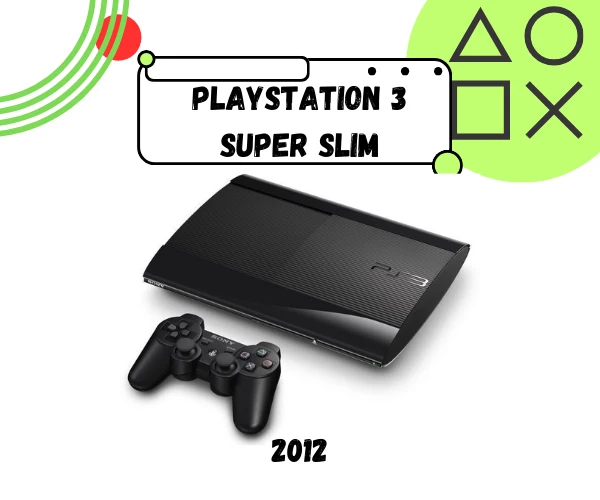
- Release date: September 2012
- Launch Prices: : $270 (250GB); $299 (500GB)
- Discontinued: October 2016
- Color: Black, White
- Media: Blu-ray, DVD, CD, digital downloads
- CPU: Cell Broadband Engine
- Resolution: Up to 1080p
- Memory: 256 MB XDR DRAM
- Storage: 250 GB, 500 GB
- Sound: Dolby Digital Plus, Dolby TrueHD, DTS-HD
- Controller Input: DualShock 3
- Connectivity: Ethernet, Wi-Fi, Bluetooth 2.0, 2 USB 2.0 ports
In 2012, Sony introduced the PlayStation 3 Super Slim. It was the smallest and lightest version of the PS3. This model was about 20% smaller and 25% lighter than the PS3 Slim, making it easy to fit in any space.
The Super Slim kept the same great performance as the previous models but came in a more compact design. It had a cool sliding disc cover with a 250 GB or 500 GB hard drive, offering plenty of space for games and movies.
Sony priced the Super Slim lower than its predecessors, making it more affordable. This move helped keep the PS3 popular, especially as newer consoles started to appear. The Super Slim’s design was practical, with a matte finish that didn’t show fingerprints or dust.
PlayStation 4 (2013)
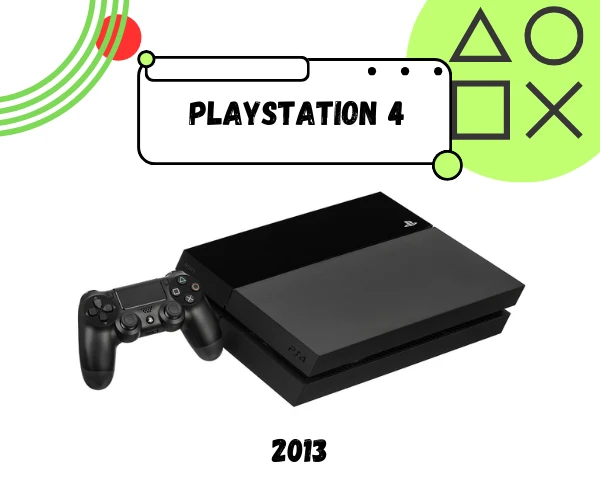
- Release date: November 2013
- Launch Prices: $399
- Discontinued: September, 2019
- Units Sold: Over 103 million
- Color: Black
- Media: Blu-ray, DVD, digital downloads
- CPU: AMD Jaguar 8-core
- Resolution: 720×480 (SD), 1280×720 (HD), 1920×1080 (Full HD)
- Memory: 8 GB GDDR5
- Storage: 500 GB, 1 TB (depending on model)
- Sound: 7.1 Surround sound
- Controller Input: DualShock 4
- Connectivity: Ethernet, Wi-Fi, Bluetooth 2.1
In 2013, Sony launched the PlayStation 4 (PS4), a big step up from the PS3. Its powerful 8-core processor and advanced graphics made games look smooth and detailed. The PS4 stood out for its 4K video capabilities, although it couldn’t play games in 4K.
Sony also revamped the controller with the PS4. The new DualShock 4 had a cool touchpad and better buttons, making gaming more fun and interactive. In addition to gaming, the PS4 was great for watching Blu-ray movies, streaming, and even social media.
One downside was that the PS4 couldn’t play older PlayStation games. But it still became super popular, selling millions worldwide. Games like ‘Uncharted 4’ were big hits on this console.
PlayStation 4 Slim (2016)
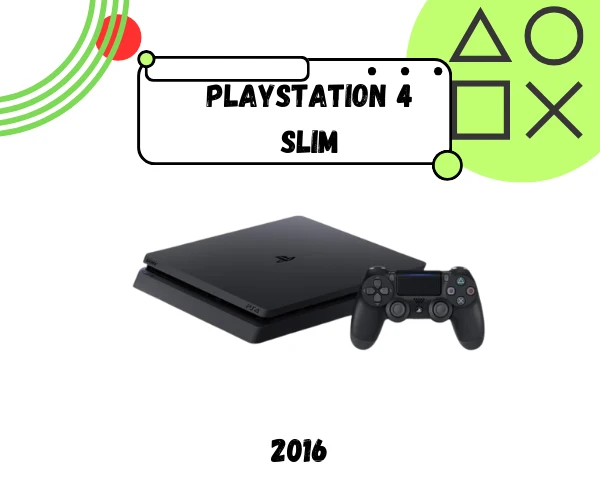
- Release date: September 2016
- Launch Prices: $299
- Color: Black
- Media: Blu-ray, DVD, digital downloads
- CPU: AMD Jaguar 8-core
- Resolution: 720×480 (SD), 1280×720 (HD), 1920×1080 (Full HD)
- Memory: 8 GB GDDR5
- Storage: 500 GB, 1 TB
- Controller Input: DualShock 4
- Connectivity: Ethernet, Wi-Fi, Bluetooth 4.0
In 2016, Sony brought out the PlayStation 4 Slim, a sleeker, more user-friendly version of the original PS4. Imagine the power of the PS4 but in a slimmer.
This console kept all the good stuff from the PS4. Thanks to its solid processor and GPU, it had the same cool games and graphics. But here’s the kicker: when it launched, it was $100 cheaper than the original PS4. That’s right- you got all that gaming goodness for less cash.
The PS4 Slim wasn’t just about saving money, though. It had faster 5GHz WiFi, making online gaming smoother. For movie buffs, the UHD Blu-ray drive was a sweet addition. The design was neat, too, with a matte finish that didn’t show dust or fingerprints easily.
But it wasn’t all perfect. The PS4 Slim didn’t support 4K gaming, which was a bummer for gamers looking for ultra-high-definition play. And some folks missed the optical audio output from the original PS4, which was handy for connecting to certain sound systems.
Overall, the PS4 Slim was a hit. It sold well, thanks to its lower price and compact design.
PlayStation 4 Pro (2016)
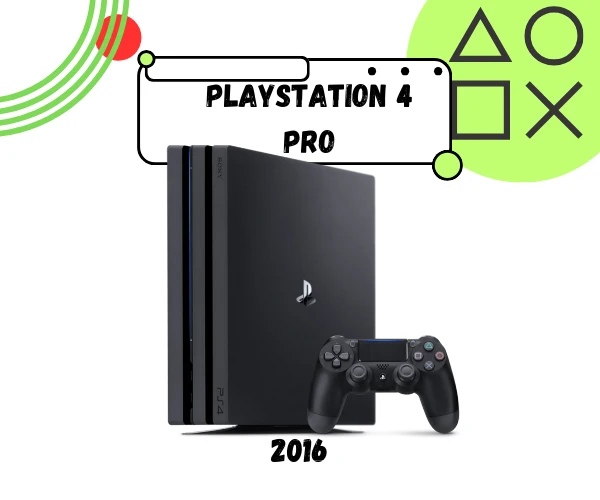
- Release date: November 2016
- Launch Prices: $399
- Color: Black
- Media: Blu-ray, DVD, digital downloads
- CPU: Upgraded AMD Jaguar 8-core
- Resolution: Up to 4K, supports HDR
- Memory: 8 GB GDDR5 + 1 GB DDR3
- Storage: 1 TB
- Sound: Surround sound
- Controller Input: DualShock 4
- Connectivity: Ethernet, Wi-Fi, Bluetooth 4.0
In 2016, Sony launched the PlayStation 4 Pro, a supercharged version of the PS4. Thanks to its 4K gaming power, the PS4 Pro was a big hit with gamers who loved top-notch graphics. The PS4 Pro had a beefier GPU and a faster CPU, making games look amazing, especially on 4K TVs.
The console also came with a big 1TB hard drive to store loads of games. It supported HDR, too, which meant brighter and more colorful visuals.
But, the PS4 Pro was bulkier and costlier than the PS4 Slim, which wasn’t ideal for everyone.
PlayStation VR (2016)
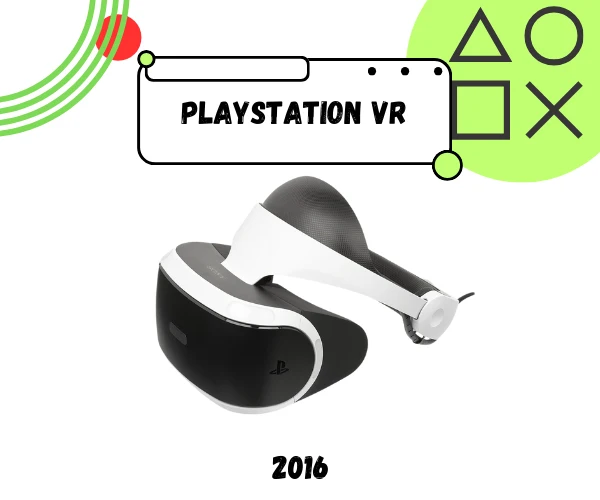
- Release date: October 13, 2016
- Launch Prices: $399
- Units Sold: Over 5 million
- Color: Black and White
- Display: 5.7″ OLED, 100° field of view
- Graphics: 1080p RGB (960 × 1080 per eye; 90–120 Hz refresh rate)
- Sound: 3D audio through the headphone jack
- Supported Controller: DualShock 4 controller, PlayStation Aim, PlayStation Move
- Compatible with: PS4, PS5
- Input: Positional tracking with 9 LEDs via PlayStation Camera
In 2016, Sony jumped into the virtual reality world with the PlayStation VR. This was a big move, bringing VR gaming to the PlayStation fans.
PlayStation VR connects to a PS4, transporting you into a 360-degree virtual world. It’s like stepping right into the game.
People had mixed feelings about it. Some loved the immersive experience, enjoying games like Astro Bot: Rescue Mission and Resident Evil 7 in VR. But others thought the headset was a bit pricey, especially since you needed a PS4.
The PlayStation VR sold well, showing people were into VR gaming. But it wasn’t perfect. The graphics weren’t always super sharp, and some found it a bit uncomfortable after a while.
PlayStation Classic (2018)
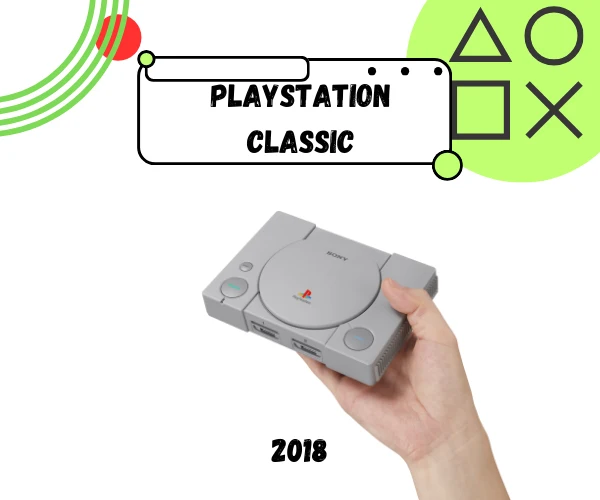
- Release date: December 2018
- Launch Prices: $99
- Color: Grey
- Media: Preloaded games
- CPU: ARM Cortex-A35
- Resolution: 720p
- Storage: Internal, preloaded with 20 games
- Controller Input: Classic PS1 controllers (replicas)
- Connectivity: HDMI, USB power
In 2018, Sony released the PlayStation Classic, a mini version of the original PlayStation. It was a throwback to the 90s, but not everyone was thrilled.
The PlayStation Classic was tiny and came with 20 pre-loaded games. But here’s the thing: it was priced at $100. Many gamers thought that was too much for just 20 games. Plus, it used a free emulator to run the games, which some people found funny.
Another surprise was the box didn’t include a power adapter. It had a USB A cable, but to actually power it up, you had to buy an adapter separately. That was a bit of a letdown.
PlayStation 5 (2020)
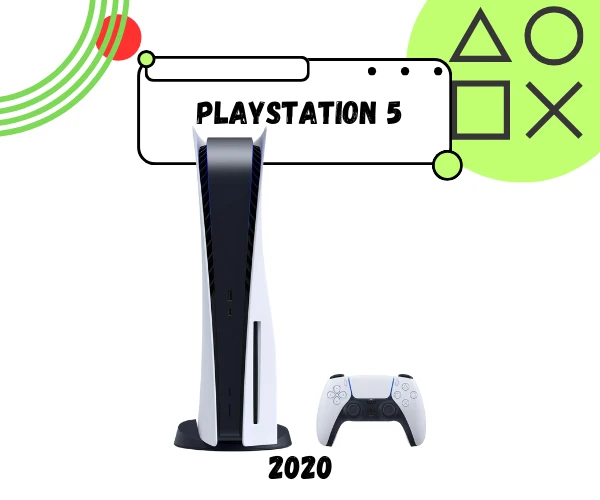
- Release date: November 12, 2020
- Launch Prices: $500
- Color: White and Black
- Media: Ultra HD Blu-ray, DVD, CD, digital downloads
- CPU: Custom 8-core AMD Zen 2, variable frequency up to 3.5 GHz
- Resolution: Supports up to 8K
- Memory: 16 GB GDDR6
- Storage: Custom 825 GB SSD
- Sound: Tempest 3D AudioTech
- Controller Input: DualSense Wireless Controller
- Connectivity: Ethernet, Wi-Fi 6, Bluetooth 5.1, USB-C, USB-A
In 2020, Sony dropped the PlayStation 5, and it was a game-changer. This new console was way ahead of the PS4 and packed with cool upgrades. Gamers everywhere were buzzing with excitement.
The PS5 came with a super-fast SSD, cutting down game loading times like never before. It also had a powerful new CPU and GPU, making games look incredibly realistic. The graphics were a huge step up, supporting 4K and even 8K resolution.
Sony also introduced the new DualSense controller with the PS5. It had haptic feedback and adaptive triggers, giving players a more immersive gaming experience. You could feel the tension in games, which was pretty cool.
The PS5’s design is something else, too. It’s bold and futuristic, really different from past consoles. Some people love its look, while others think it’s too big.
PlayStation 5 Digital Edition (2020)
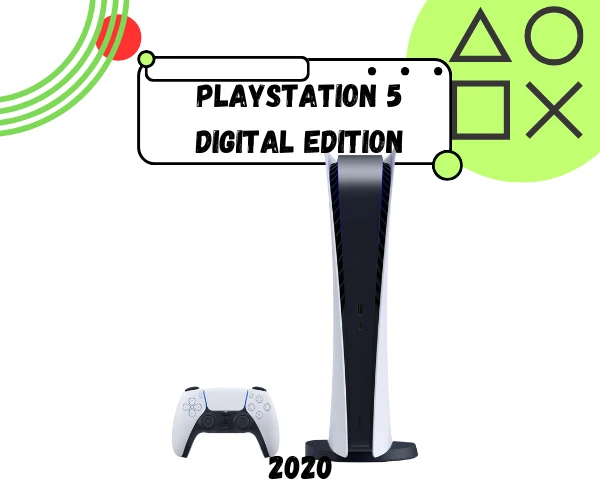
- Release date: November 12, 2020
- Launch Prices: $450
- Color: White and Black
- Media: Digital downloads only (no disc drive)
- CPU: Custom 8-core AMD Zen 2, variable frequency up to 3.5 GHz
- Resolution: Supports up to 8K
- Memory: 16 GB GDDR6
- Storage: Custom 825 GB SSD
- Sound: Tempest 3D AudioTech
- Controller Input: DualSense Wireless Controller
- Connectivity: Ethernet, Wi-Fi 6, Bluetooth 5.1, USB-C, USB-A
When Sony released the PlayStation 5 Digital Edition in 2020, it got mixed reactions from buyers. This version didn’t have a disc drive, which was a big deal for some gamers.
The PS5 Digital Edition had the same excellent features as the regular PS5- fast loading, great graphics- but it was sleeker and cheaper. Some gamers liked this digital-only idea, while others missed playing old disc games.
PlayStation VR 2 (2023)
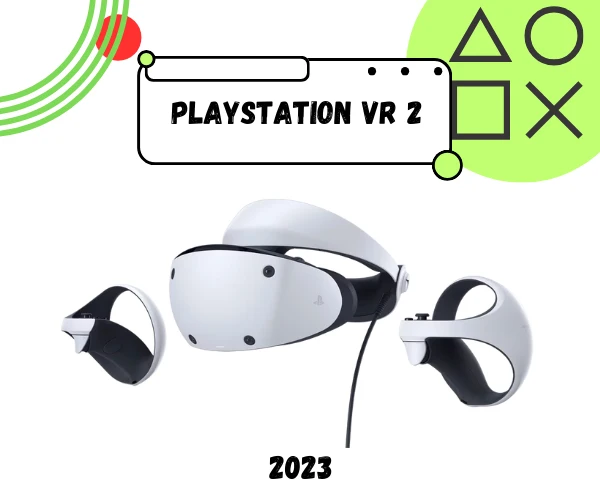
- Release Date: February 22, 2023
- Launch Price: $549.99
- Display: OLED, HDR, 110° field of view
- Graphics: 4K PenTile (2000 × 2040 per eye; 90–120 Hz refresh rate)
- Sound: 3D audio through the headphone jack
- Supported Controller: PlayStation VR2 Sense controller, Dualsense
- Compatible with: PS5
- Tracking: Inside-Out Tracking (x4 Built-in Cameras)
In 2023, Sony released the PlayStation VR 2, a big upgrade from the original PlayStation VR. This new version brought some major improvements to the VR experience.
The PlayStation VR 2 works with the PlayStation 5, offering a more immersive and realistic virtual reality. It’s got better graphics and smoother motion, making the VR world feel even more real.
One of the cool things about the PS VR 2 is its new features. It has eye-tracking and a wider field of view, making you feel more like you’re in the game. The headset is also more comfortable, which is great for longer gaming sessions.
When it came out, people were excited. But, like any new tech, it was a bit pricey, and not everyone was ready to jump in. When it hit the market, the PS VR 2 didn’t have many games specifically designed for it. This lack of games made it less popular among gamers. But it’s still early days and too soon to say how it’ll do in the long run.
Playstation PS5 Slim (2023)
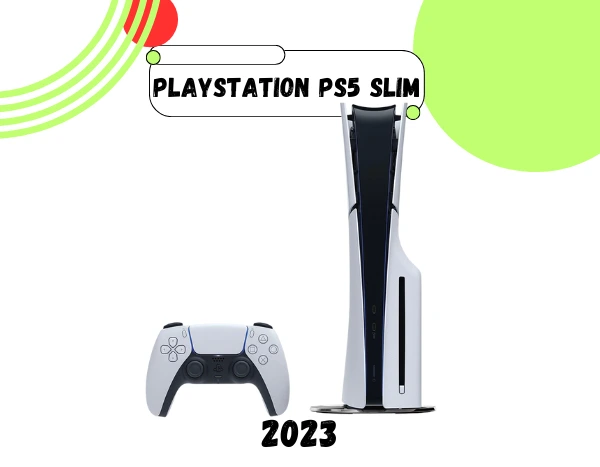
- Release Date: November 2023.
- Launch Prices: $499.99 for the Ultra HD Blu-ray disc drive version and $449.99 for the Digital Edition.
- Color: White and Black.
- Media: Supports Ultra HD Blu-ray, Blu-ray, DVD, and digital downloads—optional Ultra HD Blu-ray Disc Drive for Digital Edition.
- CPU: x86-64-AMD Ryzen “Zen 2”, 8 Cores / 16 Threads, up to 3.5 GHz.
- Resolution: Supports 4K 120Hz TVs, 8K TVs, VRR
- Memory: GDDR6 16GB.
- Storage: 1TB SSD.
- Sound: “Tempest” 3D AudioTech.
- Controller Input: USB Type-C and Type-A ports.
- Connectivity: Ethernet, Wi-Fi
Sony’s PS5 Slim launched in late 2023 with size cuts and design tweaks. This lean measures about 14.1 x 3.8 x 8.5 inches, trimming down from the previous 15.4 x 4.1 x 10.2 inches. It’s also shed nearly 3 pounds, making the disc version about 7 pounds and the digital one just under 6.
The Slim has a cool customization feature with four removable panels, letting gamers switch up the look of their console. It also comes with slim legs for laying flat, but if you want to stand it up, you’ll need to buy a separate stand.
Storage-wise, the Slim steps up with a 1 TB SSD, a nice bump from the old 825 GB. And if you decide you’re into physical games, you can add on a disc drive later.
Performance stays solid with the same AMD Ryzen eight-core processor and RDNA 2 graphics card, so gameplay remains smooth. Just a heads-up, its slim profile means less space inside for air to flow, potentially leading to a slight heat bump, but nothing too hot to handle.

